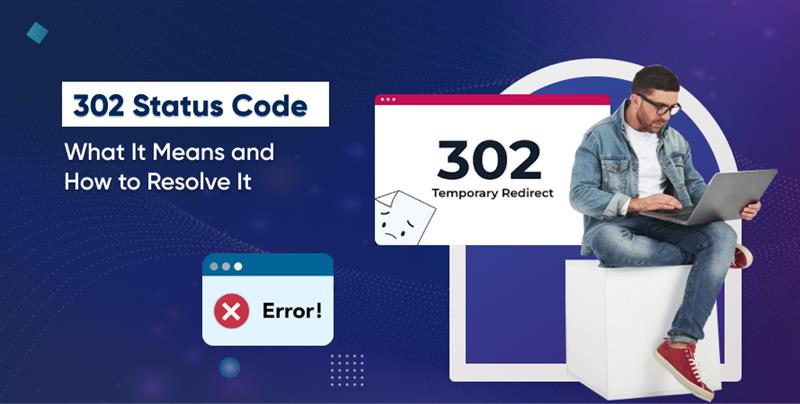302 Status Code: What It Means and How to Resolve It



Introduction
When managing a website, every second counts, not just in loading speed, but in the accuracy and clarity of how the server communicates with browsers and search engines. One critical aspect of this communication is the use of HTTP status codes, which tell users and bots what’s happening behind the scenes when a URL is accessed.
Among these codes is the 302 HTTP status code, often misunderstood or misused. Though it’s intended for temporary redirection, it can significantly impact user experience, site performance, and even SEO rankings if not implemented properly.
In this blog, we’ll demystify the 302 HTTP code, explain what it means, show you how to identify and resolve it, and offer expert-backed best practices. Whether you’re a developer, SEO expert, or business owner, this guide will give you the clarity and tools to handle the status 302 code with confidence.
What Is the 302 Status Code?
The HTTP status ‘code 302 found’ means “Temporarily Moved“. It indicates that the requested resource has temporarily been moved to a different URL, and the client (browser or crawler) should access it using that new URL for now—but not update the original reference.
This redirection is temporary, and the client is expected to continue using the original URL for future requests.
Example:
If example.com/page-a returns a 302 redirect to example.com/page-b, the browser is told to visit page-b only for now, and it should still request page-a in the future.
This is in contrast to 301 (Moved Permanently), where the browser should update the URL permanently.
What Does 302 Mean in HTTP Requests?
In the context of HTTP requests, 302 means that the client was able to communicate with the server, but the resource it requested is available at a different URI—temporarily.
When a browser receives a 302 response, it typically follows the redirect automatically. However, this behavior can be influenced by HTTP headers and caching rules.
Key Characteristics:
- It uses a Location header to indicate the new temporary URL.
- It allows search engines and browsers to understand that this is not a permanent move.
The original URL remains indexed by search engines.
Common Causes of Status Code 302
A status code 302 can be returned for a variety of reasons, many of which are unintentional or misconfigured. Let’s explore the most common ones:
1. Server Misconfiguration
Web servers like Apache or NGINX might return 302 redirects due to incorrect .htaccess or nginx.conf rules.
2. Faulty CMS Plugins
WordPress plugins that handle redirects or caching might unintentionally issue 302s due to misconfigured settings.
3. Login Redirects
Many authentication systems use 302 redirects to send unauthenticated users to a login page temporarily.
4. Programmatic Logic Errors
In frameworks like Django, Flask, Express.js, or Laravel, developers may use a 302 instead of a 301 when coding redirects.
5. Content Delivery Networks (CDNs)
Services like Cloudflare, Akamai, or Fastly can trigger error code 302 if improperly configured, especially when dealing with mobile optimization or geo-routing.
How to Identify a Return Code 302
Before resolving a 302 code status issue, you must identify where it’s coming from. Here are some effective methods:
1. Browser Developer Tools
- Open Chrome DevTools → Network tab
- Reload the page and inspect the request’s Status column
- Look for 302 Found and review the Location header
2. Command Line Tools
Use curl to see headers directly:
curl -I https://yourwebsite.com/page
Look for:
HTTP/1.1 302 Found
Location: https://yourwebsite.com/new-page
3. SEO and Redirect Tools
- Screaming Frog
- Ahrefs Site Audit
- SEMrush
- GTmetrix (for redirect chains)
These tools can help track down unwanted 302 redirects and their sources.
How to Fix 302 Redirect Errors (Step-by-Step)
Now that you’ve found the source of the HTTP 302 status code, it’s time to fix it. Here’s a breakdown based on common causes:
A. Fix Server Configurations
Apache (.htaccess)
Redirect 301 /old-page /new-page
If you find:
Redirect 302 /old-page /new-page
Change it to 301 if the change is permanent.
NGINX
return 302 https://example.com/new-page;
Update to:
return 301 https://example.com/new-page;
B. Update Application Logic
PHP Example
header(“Location: /new-page”, true, 302); // temporary
Change to:
header(“Location: /new-page”, true, 301); // permanent
Node.js Example
res.redirect(302, ‘/new-page’);
Fix:
res.redirect(301, ‘/new-page’);
C. Fix CMS/Plugin Settings
- Use plugins like Redirection (WordPress) to manage redirect types
- Ensure WooCommerce or login plugins don’t force 302s unnecessarily
- Disable or reconfigure caching plugins that generate temporary redirects
D. Check CDN Rules
In Cloudflare, review:
- Page Rules
- Redirects via Workers or Transform Rules
- Geo-based redirection settings
- Update any temporary rules to permanent if needed.
SEO Impact of HTTP Code 302
From an SEO perspective, code 302 should be used carefully.
Google’s Behavior:
- Googlebot treats 302 as temporary and does not pass link equity like a 301.
- If a 302 persists over time, Google may start treating it as a 301.
- Temporary redirects can lead to crawl inefficiencies and indexing issues.
SEO Mistakes to Avoid:
- Using 302 for permanent moves
- Creating redirect chains or loops
- Forgetting to update sitemap or internal links
302 Status Code Best Practices
Follow these guidelines to use status 302 responsibly:
- Use it only when the redirect is genuinely temporary
- Avoid chaining multiple 302 redirects
- Always provide a clear Location header
- Monitor 302 redirects regularly with audit tools
- Don’t use 302 when moving domains or site sections permanently
302 in Programming Context
Here’s how developers can implement HTTP 302 redirects in various languages.
PHP
header(“Location: /temporary”, true, 302);
exit;
Python (Flask)
from flask import redirect
return redirect(“/temporary”, code=302)
Django
from django.shortcuts import redirect
return redirect(‘/temporary’)
Node.js (Express)
res.redirect(302, ‘/temporary’);
Java
response.setStatus(HttpServletResponse.SC_FOUND);
response.setHeader(“Location”, “/temporary”);
Make sure to use 302 only for cases that will be reverted. For everything else, use 301.
How to Monitor and Prevent 302 Issues Proactively
Don’t wait for SEO damage or user complaints to discover problematic redirects. Use these monitoring methods:
Use Google Search Console:
- Inspect URL behavior
- Check for unexpected redirects
Log Analysis:
- Server access logs reveal where code 302 is issued
- Use Logz.io or Splunk to analyze redirect patterns
Site Audits:
Run audits with tools like:
- Ahrefs
- Screaming Frog
- Sitebulb
These will detect:
- Long redirect chains
- Loops
- Improper 302 usage
Advanced Troubleshooting Tips
Redirect Loops
A 302 can trigger a loop if the destination URL redirects back to the original.
Fix: Carefully trace the Location headers and ensure no cyclic redirection is occurring.
Cache Conflicts
Browsers sometimes cache 302 responses unexpectedly. Use:
Cache-Control: no-store
to avoid storing temporary redirects.
HSTS Conflicts
If you’re using HTTP Strict Transport Security (HSTS), redirects from HTTP to HTTPS should be 301, not 302.
Fix: Ensure your web server is returning permanent HTTPS redirects.
Conclusion
The 302 status code plays a critical role in HTTP communication, acting as a signal for temporary redirection. While it’s useful in the right scenarios, improper use of status code 302 can lead to SEO issues, user confusion, and technical inefficiencies.
By understanding what http response code ‘302’ means, learning how to identify its use, and following best practices for resolving it, you can ensure your site functions optimally for both users and search engines.
Need help optimizing your website’s redirects, load times, or overall performance? Hire Core Web Vitals Consultants to ensure everything—from HTTP headers to Core Web Vitals—is fully optimized.
Frequently Asked Questions (FAQs)
A 302 status code is used to indicate that a requested URL has temporarily moved to a different location. It tells web browsers and crawlers to use the new location for now, but continue referencing the original URL.
A 301 redirect is permanent and signals search engines to pass link equity to the new URL. A 302 is temporary and doesn’t transfer ranking signals, as the original URL is expected to be used again.
Yes. Since it’s temporary, search engines may not transfer authority or indexing preference to the redirected URL. Misusing 302s can lead to poor crawl efficiency and missed ranking opportunities.
Use browser DevTools, curl, or SEO audit tools like Ahrefs or Screaming Frog. Look at the response headers and identify whether the server is returning a status 302 and what URL it’s pointing to.
If the redirect is permanent (such as a moved page or domain migration), yes. A 301 redirect is more appropriate and SEO-friendly. Use 302 only when the redirect is temporary and will be reversed.